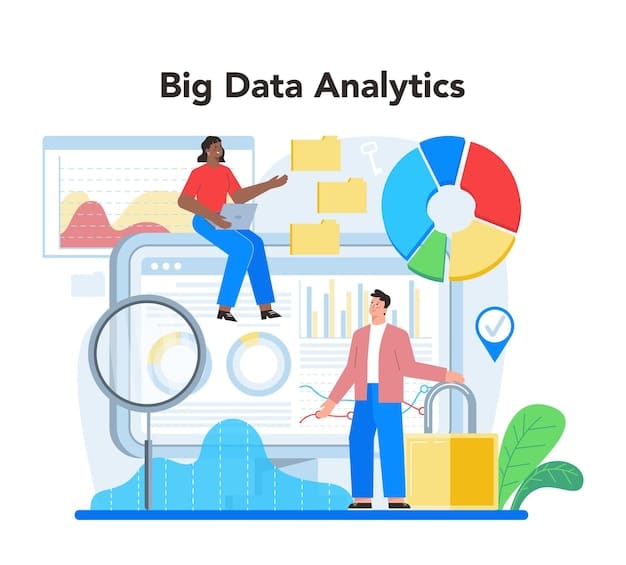The Role of Automation in Data Analytics for US Companies

Automation significantly enhances data analytics for US companies by streamlining processes, improving accuracy, and enabling quicker, more data-driven decision-making.
In today’s fast-paced business environment, data is a critical asset. For US companies, the ability to analyze data quickly and accurately can be a significant competitive advantage. That’s where **the role of automation in enhancing data analytics for US companies** comes in.
Understanding the Basics of Data Analytics
Data analytics involves examining raw data to draw conclusions about that information. It’s a broad field encompassing various techniques and processes to extract insights from data. Understanding these basics is crucial before exploring how automation can enhance the process.
Types of Data Analytics
Data analytics can be categorized into four main types: descriptive, diagnostic, predictive, and prescriptive. Each type serves a different purpose and provides unique insights.
- Descriptive Analytics: This involves summarizing historical data to identify patterns and trends.
- Diagnostic Analytics: This focuses on understanding why certain events occurred by examining the data for root causes.
- Predictive Analytics: This leverages statistical models and machine learning techniques to forecast future outcomes.
- Prescriptive Analytics: This goes a step further by recommending actions based on the insights gained from predictive analytics.

Each of these types of analytics plays a vital role in helping businesses make informed decisions. By understanding what happened, why it happened, what might happen, and what to do about it, companies can optimize their strategies and improve their performance.
The Rise of Automation in Business Processes
Automation is rapidly transforming various aspects of business, and its impact on data analytics is particularly profound. Automation involves using technology to perform tasks that were previously done manually, increasing efficiency and reducing errors.
What is Automation?
Automation refers to the use of technology to execute processes with minimal human intervention. This can range from simple tasks like data entry to complex processes like robotic process automation (RPA).
The benefits of automation are numerous. It helps companies reduce operational costs, improve accuracy, increase productivity, and free up employees to focus on more strategic tasks. In the context of data analytics, automation can streamline data collection, preprocessing, analysis, and reporting.
Automation is not just about replacing human workers with machines. It’s about augmenting human capabilities and enabling employees to work more effectively. By automating repetitive and mundane tasks, companies can empower their employees to focus on higher-value activities such as interpreting data insights and developing strategic recommendations.
How Automation Enhances Data Collection
Data collection is the foundation of any data analytics process. Traditionally, data collection can be time-consuming and prone to errors. Automation can significantly improve the efficiency and accuracy of data collection efforts. Automating data collection allows US companies to gather information more efficiently, reduce errors, and ensure data quality.
Automated Data Extraction
Automated data extraction involves using software to automatically pull data from various sources, such as websites, databases, and documents. This eliminates the need for manual data entry and reduces the risk of errors.
For example, web scraping tools can automatically extract data from websites, while optical character recognition (OCR) technology can convert scanned documents into machine-readable text. These tools enable companies to collect data from a wide range of sources quickly and accurately.
Another key benefit of automated data extraction is its ability to handle large volumes of data. Manual data entry can be overwhelming and error-prone when dealing with large datasets. Automation ensures that data is collected efficiently and accurately, regardless of the data volume.
Improving Data Quality Through Automation
Data quality is essential for accurate analysis. Inaccurate or incomplete data can lead to flawed insights and poor decision-making. Automation can play a crucial role in improving data quality by ensuring data is consistent, complete, and accurate.
Data Cleansing and Validation
Data cleansing involves identifying and correcting errors in the data, such as missing values, inconsistencies, and duplicates. Automation can streamline this process by using algorithms to automatically detect and correct errors.
- Automated Data Cleansing: Tools can identify and correct inconsistencies, such as formatting errors or incorrect values.
- Data Validation: Automated validation rules can ensure that data meets predefined criteria, such as data types, ranges, and formats.
- Duplicate Detection: Automation can identify and remove duplicate records, ensuring data accuracy and consistency.
By automating data cleansing and validation, companies can ensure that their data is accurate and reliable. This improves the quality of insights derived from data analytics and enables more informed decision-making.
Automation in Data Processing and Analysis
Data processing and analysis are critical steps in the data analytics process. These steps involve transforming raw data into meaningful insights. Automating these processes can significantly speed up analysis and improve accuracy.

Automated Data Transformation
Data transformation involves converting data into a format that is suitable for analysis. This can include tasks such as data normalization, aggregation, and enrichment.
Automation tools can perform these transformations automatically, ensuring data is consistent and ready for analysis. For example, tools can automatically convert data from different sources into a common format, making it easier to analyze.
By automating data transformation, companies can save time and effort and ensure that data is consistent across different sources. This improves the accuracy and reliability of data analysis.
The Benefits of Automation for US Companies
The benefits of automation in data analytics are significant for US companies. From increased efficiency to improved accuracy, automation can transform how companies analyze data and make decisions.
Increased Efficiency and Productivity
Automation can significantly increase efficiency and productivity by streamlining data analytics processes. By automating tasks such as data collection, cleansing, and analysis, companies can reduce the time and effort required to extract insights from data.
This increased efficiency translates into cost savings and improved productivity. Employees can focus on higher-value tasks such as interpreting data insights and developing strategic recommendations.
Moreover, automation enables companies to analyze data in real-time, providing timely insights that can inform immediate decisions. This is particularly valuable in fast-paced industries where timely information can be a competitive advantage.
| Key Point | Brief Description |
|---|---|
| 🚀 Automated Data Collection | Efficient data gathering from various sources. |
| ✅ Improved Data Quality | Ensuring accuracy and consistency in data. |
| ⏱️ Faster Data Processing | Quick transformation and analysis of data. |
| 💡 Better Decision-Making | Informed decisions based on accurate insights. |
Frequently Asked Questions (FAQ)
▼
Automation reduces human error in data entry and processing by using predefined rules and algorithms, ensuring consistency and accuracy in the data.
▼
All types of data analytics benefit, but predictive and prescriptive analytics gain significantly from automation, allowing for real-time insights and optimized decision-making.
▼
Yes, small businesses can leverage automation to streamline data processes, gain insights, and compete more effectively with larger organizations.
▼
The cost varies, but many affordable solutions are available. The long-term benefits, such as increased efficiency and better decisions, often outweigh the initial investment.
▼
Skills in data management, understanding of analytics tools, and the ability to interpret insights are essential. Continuous learning and adaptation are also key.
Conclusion
In conclusion, the integration of automation into data analytics offers US companies a significant opportunity to enhance efficiency, improve accuracy, and gain deeper insights. By automating data collection, processing, and analysis, businesses can make more informed decisions and drive growth in an increasingly competitive landscape.





